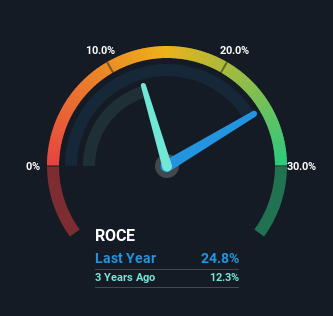- South Africa
- /
- Hospitality
- /
- JSE:SUI
Shareholders Would Enjoy A Repeat Of Sun International's (JSE:SUI) Recent Growth In Returns
If we want to find a potential multi-bagger, often there are underlying trends that can provide clues. One common approach is to try and find a company with returns on capital employed (ROCE) that are increasing, in conjunction with a growing amount of capital employed. Ultimately, this demonstrates that it's a business that is reinvesting profits at increasing rates of return. With that in mind, the ROCE of Sun International (JSE:SUI) looks great, so lets see what the trend can tell us.
What Is Return On Capital Employed (ROCE)?
Just to clarify if you're unsure, ROCE is a metric for evaluating how much pre-tax income (in percentage terms) a company earns on the capital invested in its business. To calculate this metric for Sun International, this is the formula:
Return on Capital Employed = Earnings Before Interest and Tax (EBIT) ÷ (Total Assets - Current Liabilities)
0.25 = R2.4b ÷ (R14b - R3.7b) (Based on the trailing twelve months to December 2022).
Thus, Sun International has an ROCE of 25%. On its own, that's a very good return and it's on par with the returns earned by companies in a similar industry.
Check out our latest analysis for Sun International

While the past is not representative of the future, it can be helpful to know how a company has performed historically, which is why we have this chart above. If you're interested in investigating Sun International's past further, check out this free graph of past earnings, revenue and cash flow.
What Does the ROCE Trend For Sun International Tell Us?
We're pretty happy with how the ROCE has been trending at Sun International. The figures show that over the last five years, returns on capital have grown by 108%. That's a very favorable trend because this means that the company is earning more per dollar of capital that's being employed. Speaking of capital employed, the company is actually utilizing 48% less than it was five years ago, which can be indicative of a business that's improving its efficiency. Sun International may be selling some assets so it's worth investigating if the business has plans for future investments to increase returns further still.
The Bottom Line On Sun International's ROCE
From what we've seen above, Sun International has managed to increase it's returns on capital all the while reducing it's capital base. Given the stock has declined 33% in the last five years, this could be a good investment if the valuation and other metrics are also appealing. So researching this company further and determining whether or not these trends will continue seems justified.
Like most companies, Sun International does come with some risks, and we've found 2 warning signs that you should be aware of.
If you'd like to see other companies earning high returns, check out our free list of companies earning high returns with solid balance sheets here.
New: Manage All Your Stock Portfolios in One Place
We've created the ultimate portfolio companion for stock investors, and it's free.
• Connect an unlimited number of Portfolios and see your total in one currency
• Be alerted to new Warning Signs or Risks via email or mobile
• Track the Fair Value of your stocks
Have feedback on this article? Concerned about the content? Get in touch with us directly. Alternatively, email editorial-team (at) simplywallst.com.
This article by Simply Wall St is general in nature. We provide commentary based on historical data and analyst forecasts only using an unbiased methodology and our articles are not intended to be financial advice. It does not constitute a recommendation to buy or sell any stock, and does not take account of your objectives, or your financial situation. We aim to bring you long-term focused analysis driven by fundamental data. Note that our analysis may not factor in the latest price-sensitive company announcements or qualitative material. Simply Wall St has no position in any stocks mentioned.
About JSE:SUI
Sun International
Owns and operates casino, hotel, and resort properties in South Africa.
Undervalued established dividend payer.
Market Insights
Community Narratives




